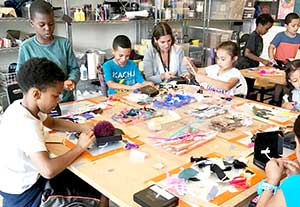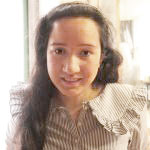
The arts operation embraces change.
By Shira Laucharoen
Somerville Wire
Marina Seevak’s first job out of college was at the Boston Children’s Museum, where there was a recycle center, and that was how she became hooked on the idea of creative reuse. She eventually got a cubicle at the Artisan’s Asylum maker’s space and she began to email hundreds of companies, asking them to send their scrap materials to her. Handing out colorful foam and sparkly fabric from barrels, she would give bags of materials away for free to local teachers. That was how The Beautiful Stuff Project started.
The operation eventually moved to East Somerville, and teachers would come by to fill a bag with whatever odds and ends they found. Seevak did all of this free of charge, because she is “a teacher, not a businesswoman. This started as a labor of love.” This model became unsustainable, so she started the offer of $10 per bag. The Beautiful Stuff Project relocated to Magoun Square, where their storefront is currently based.
“My drive is that I believe in the value of ‘loose parts’ –it’s an academic term for these open ended materials,” said Seevak. “My drive is to get those into classrooms, to get kids being able to play and think creatively.” She added, “I had a son and a foster son who really didn’t thrive in traditional, academic classrooms. So I began to see the power and need for hands-on [work] in classrooms. There’s been such a rise in anxiety among kids, and they don’t have time to free play. There are lots of direct links between the fact that classrooms are so academically driven and the high rate of anxiety and stress.”
Seevak instituted something known as the “Treasure Box Curriculum” in Somerville public schools, bringing recycled materials to classrooms and encouraging children to explore, experiment, and discover. She also began a professional development program that teachers have taken advantage of, learning about the Treasure Box Curriculum and how to incorporate The Beautiful Stuff Project’s philosophy into their programs. Seevak said that their unique, pedagogical approach is developmentally important for younger children, especially during COVID times.
“Kids need time to play—they need time for free play,” said Seevak. “That time has really been whittled away in schools. … It’s not the teachers. There are a lot of demands. Kids are needing to learn to read earlier; there’s all kinds of testing. There’s so much research that shows that kids need to play. It’s a pretty simple thing. That’s why I created this very easy, accessible way to both model free play and have kids be able to play. Teachers will also say that kids don’t know what to do anymore.” Regarding the pandemic, she added, “It was really hard to have hands on materials for kids to have at home, when they were fully remote.”
At the onset of the pandemic, The Beautiful Stuff Project closed its storefront and had to pivot to a different model. Community Arts Director Emily Bhargava said that the team began thinking of ways that they could help the community.
“One of the huge gaps that we recognized was that food was being provided to community members that needed it but that diapers were not,” said Bhargava. “Our storefront, which was not open to the public, became a diaper distribution and donation site. We worked with the City to make free diapers available to families, but that is not our core mission. It was just an immediate need. So we also pivoted our programming and moved all of the professional development for teachers that we had been doing in person online. We started to prepare boxes and bags of materials for families who didn’t have things at home for kids to stay busy with and stay creative with. We’ve made and delivered thousands, over the course of the pandemic. We worked with art teachers to get materials to kids who didn’t have any, as well, and to whole classes, whole grades, and whole schools.”
Starting last fall, The Beautiful Stuff Project has also been creating StoryWalks, using mosaic tiles to illustrate pages from storybooks that accompany a path or wall. They set up outdoor, COVID-safe mosaic tiling sessions, inviting community members to participate in design. One StoryWalk, “Dandelion Days,” was hung at the Winter Hill School playground and at the fence of the Somerville Community Growing Center. It is now at the Capuano School playground. The Somerville Public Library Kids Book Club is writing and illustrating a new StoryWalk, with funding from the Somerville Arts Council, and they are making a new piece about kids’ experiences with COVID.
Ilana Cohn, a teacher at the Argenziano School, described how Seevak used to come into her classroom and create a center in the room, an area where she brought different materials, and was very intentional about referring to loose parts as “beautiful stuff,” acknowledging their value. Cohn said that the enthusiasm of her students was always palpable.
“[I notice] the kids’ joy and excitement, the feeling in the room of everyone creating,” said Cohn. “It’s really amazing; everything kind of shifts. The kids who might not shine in all of the academics have this opportunity to be expressive, and there’s a lot of language development. There’s a lot of connections and collaborations between kids, seeing what some of them are doing and getting inspired by it. Their wonder, excitement, and joy really come out in every encounter. It’s this beautiful breath of childhood.”
The pandemic has presented challenges for The Beautiful Stuff Project, and Seevak said that while it has always been a lot of work to keep the storefront running, the virus created increased difficulties. For this reason, she is planning on closing down the retail piece of what they do, most likely by the end of August, explaining that the storefront for shopping was not financially sustainable. They will continue to do their curriculum work with classrooms, professional development for teachers, and Bhargava’s community art projects. Seevak emphasized that The Beautiful Stuff Project is not going away but instead will be streamlining and focusing on what they do best.
“If you drive by the Winter Hill School, there are these beautiful mosaic pillars out by the front door that [Bhargava] created as a collaborative art project. This kind of work is the heart and soul of what we do,” said Seevak. “We loved having the storefront as a home base, to have all our materials there and be a kind of creative hub. But even though holding on to the storefront is not tenable during these times, the pulse of our work will live on and we will continue to be deeply rooted in the schools and the community.”

Shira Laucharoen is assistant director of the Boston Institute for Nonprofit Journalism and assistant editor and staff reporter of the Somerville Wire.















Reader Comments